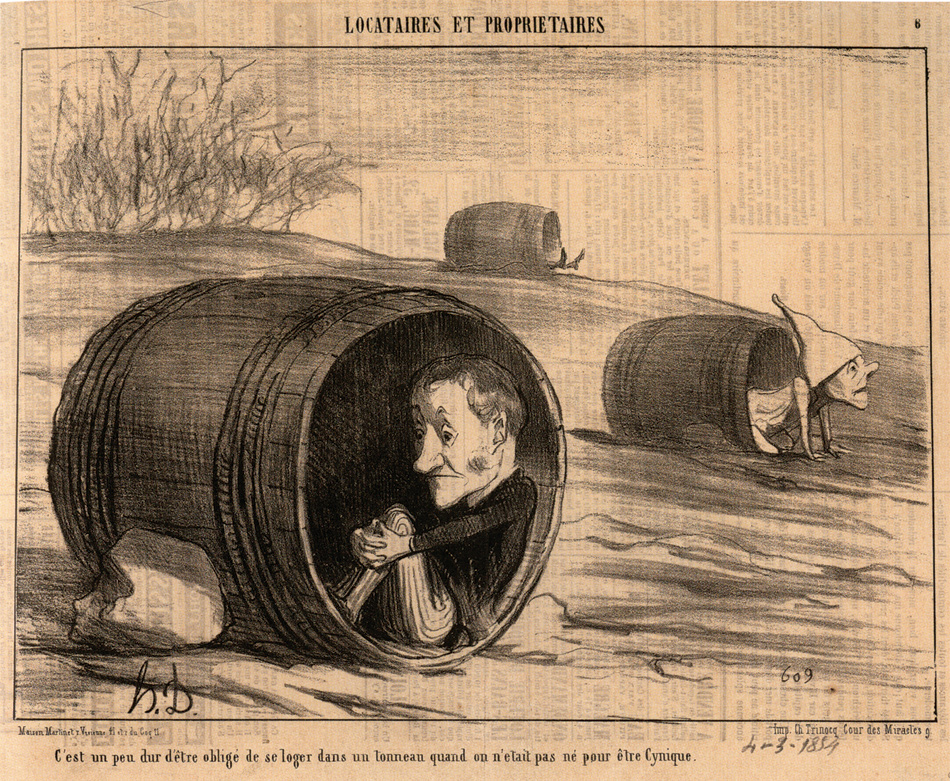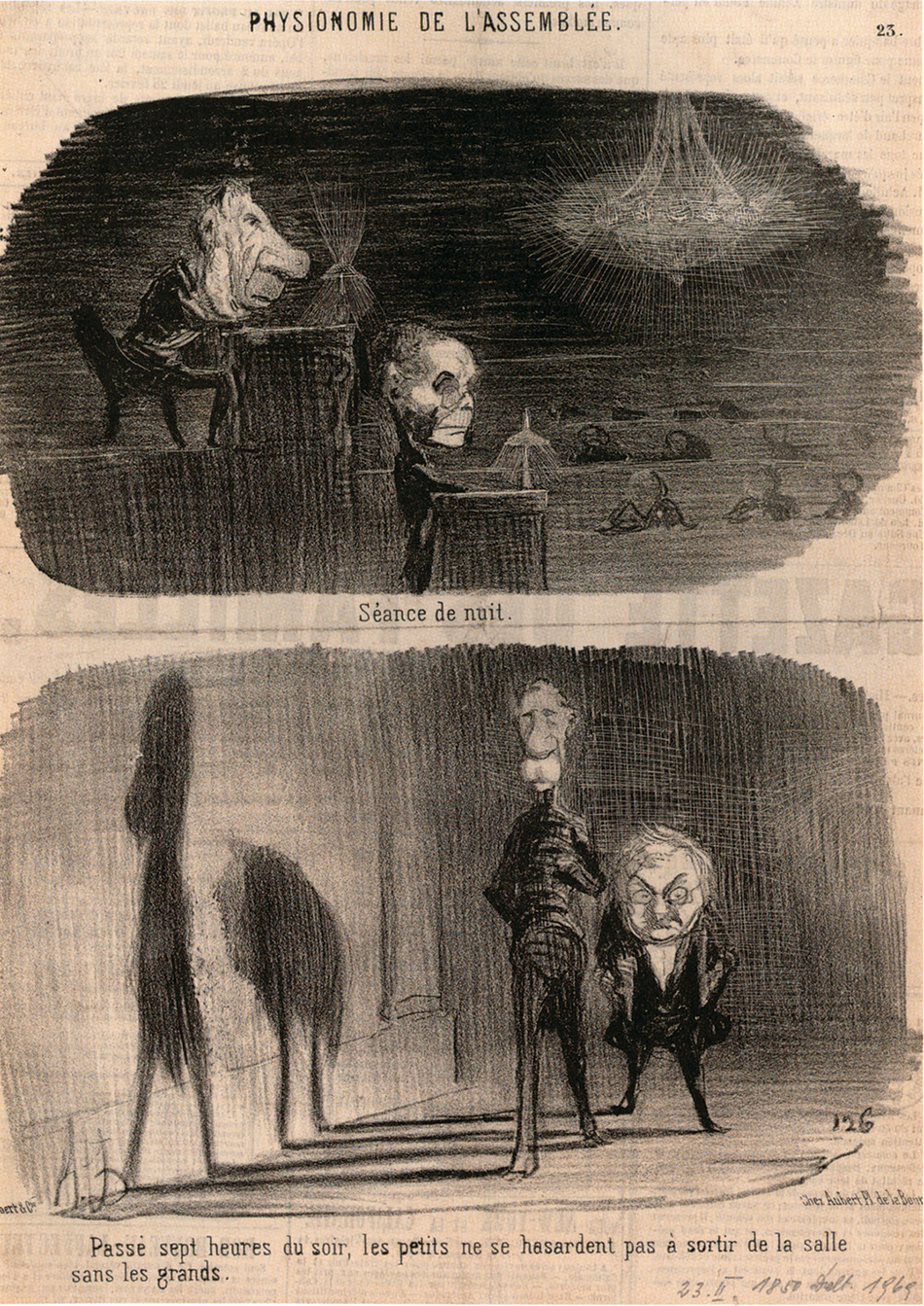
Staatliche Graphische Sammlung München
Honoré Daumier: ‘It’s a bit hard to be obliged to live in a barrel when one wasn’t born to be a Cynic’; from the series ‘Tenants and Landlords,’ Le Charivari, March 4, 1854. The lithograph illustrates the housing shortage in Paris under Napoleon III by playing on the story of the Greek cynic philosopher Diogenes, who slept in a barrel.
The Staatliche Graphische Sammlung in Munich has a remarkable new acquisition: over three thousand lithographs and thirty woodcuts by Honoré Daumier produced between 1833 and 1872, the politically and socially stormy decades in France between the reign of the Citizen King Louis Philippe and the Third Republic. In adding them to the more than seven hundred Daumier lithographs and woodcuts already in its possession, the museum now has the largest collection of his prints in Germany—where the French caricaturist is frequently exhibited—and not many collections elsewhere can match it.* But the popularity of his works often goes no further than finding them entertaining and misses their explosive political significance and their physiognomic perceptiveness. Daumier’s prints reflect a critical public culture that has largely been forgotten.
On the eve of the July Revolution of 1830, the police of the doomed regime of Charles X confiscated the presses of liberal and radical newspapers. The demand for freedom of the press was one of the most important motives for the revolution that forced Charles X, the last Bourbon monarch to be crowned in Reims, from his throne and replaced him with the Citizen King Louis Philippe. Paris at the time was a hothouse of opposition newspapers: Les Amis du peuple, Le Patriote de 1830, L’Avenir—to say nothing of Le Journal des Ouvriers. One of the revolutionaries manning the barricades in July 1830 was a completely unknown twenty-two-year-old graphic artist named Honoré Daumier. He would remain a fervent republican to the end of his life.
At the same time, satiric journals—both dailies and weeklies—were being founded in Paris, journals whose heir Le Canard enchainé survives to this day. Although a more liberal press law was enacted in December 1830, it still did not put a complete halt to punitive interventions by the censors. Again and again, these publications were forced to retreat from vehement political commentary to a critique of society and manners that was only apparently harmless. In 1829 La Silhouette, the first publication of this kind, appeared, but it lasted only two years. It was followed in 1830 by La Caricature, which survived until 1835. Baudelaire called it “a satirical comedy in which all the political dignitaries appear in ridiculous costumes.” The next satirical paper to come along, Le Charivari, appeared in late 1832 and became an established part of the Parisian scene. Its subtitle was “The Journal That Publishes a New Picture Every Day.”
The same journalistic entrepreneur, Charles Philipon (1800–1861), was behind all three papers. He got his start in a gallery that sold lithographs and caricatures. His brilliant idea was to combine both with a daily paper, thereby creating an organ for public mockery. Lithography, invented in Munich by Alois Senefelder (1771–1834), first became known in France under Napoleon I as a method for printing musical scores. For illustrations, the broader tonal spectrum of chalk lithography was needed. Thanks to that technical advance, caricature was able to establish itself as a graphic statement in the satiric press.
The predecessors of these new, mocking images were to be found in England, home of the first modern newspapers and novels. But transplanted to Paris, the caricature found itself confronted with a society more sharply divided into estates and classes. Most important, it was open to influence by traditions of satirical physiognomy reaching back to moralists such as La Bruyère and courtly observers such as Saint-Simon. Around 1830, the work of those witty anthropologists—with no small amounts of gossip and malice—flowed into “physiologies,” catalogs of the masks and foibles, the visages and costumes of bourgeois society.
This inheritance was important both for novelists like Hugo and Balzac and for the caricaturists. They would encounter one another in the editorial offices. When Philipon introduced Balzac to Daumier, the frequently hyperbolic novelist said, “This fellow has something of Michelangelo under his skin.” The “recording secretary” of French society recognized in Daumier his iconographic equal.
In the satirical dailies, the caricaturist was the graphic partner of the journalist, producing witty illustrations for the following day. Between 1833 and 1872, Daumier published over three thousand lithographs in Le Charivari. Their subjects range over the entire spectrum of public and private life in bourgeois Paris, from politics to the courts, the banks, and real estate, from food and drink to music and art. This flood of images has been compared to Balzac’s Comédie humaine—a somewhat loose comparison, but it makes clear Daumier’s reputation as France’s most visually incisive and socially visionary caricaturist.
Advertisement
Daumier’s current popularity is somewhat puzzling. One exhibition after another shows the same works: Louis Philippe as a pear, judges, lawyers, and the Représentants représentés (represented representatives) of the National Assembly as physiognomic specimens. The exhibition in Munich avoids such clichés and shows, as much as possible, complete series of prints on particular subjects, such as “Tenants and Landlords” or “Philanthropists.” They are hung in two rows, one above the other, against blue-gray walls, and invite viewers to read them in sequence. The tone varies from the idyllic to harmless jokes to caustic wit. Often, two figures face each other in conversation. They argue or comment upon the bad times. Daumier’s caricatures depend on their sharply worded captions—their quick, pointed Parisian wit. It’s hard to know who decided on the subjects—the editor or the caricaturist. It was probably Philipon who wrote the texts; Daumier was not a free artist—he turned out piecework for the insatiable demands of the metropolitan press.
Censorship limited the scope of political caricatures, and in 1832 both Philipon and Daumier spent time in prison for lèse-majesté. Caricatures therefore had to adopt disguises, and the two developed highly imaginative strategies to circumvent the censors. In the series entitled “Bal de la Cour,” published between January and March 1833, the reactionaries of the time file by in suggestive costumes. Marthe-Camille Bachesson de Montalivet, the hated minister of the interior, appears as an obsequious toady—a pastry chef at the court banquet serving a candied pear. Daumier’s political caricatures blossomed during the Second Republic, between 1848 and 1852. The series “Physionomie de l’Assemblée” exploits the ancient tradition of using the human face as a source of mockery (see illustrations below). The assemblymen are marionette-like figures with oversized heads, hideous noses, greedy jaws, and disheveled hair. They shriek and whisper, wave their arms, and prance about, a hideous species exposed to public ridicule.

Staatliche Graphische Sammlung München
Two lithographs from Daumier’s series ‘Physionomie de l’Assemblée,’ Le Charivari, February 23, 1850. Above, ‘Night Session’ shows the French assemblymen André-Marie-Jean-Jacques Dupin and Alexandre Olivier Glais-Bizoin; below, ‘After 7 PM, the little ones are afraid to leave the room without the big ones’ shows Eugène Casimir Lebreton and Adolphe Thiers, whose shadows appear as birds.
The series “Idylles Parlamentaires,” which appeared between September 1850 and February 1851, turns the travesty around. The same politicians appear here as figures from classical mythology. The infamous Adolphe Thiers, who had been prime minister twice and was later president, whispers in the ear of a hermlike statue of a fawn god, which looks like the Comte Molé. In the accompanying verse, Thiers confides, “I pretend to love her with a discreet and tender passion, the young Republic. But I’m not Platonic; I’m going to violate her Constitution.” Such lines are not meant as a salacious throwback to the libertine spirit of the waning ancien régime, but rather as a mythological version of contemporary political criticism. It is a punning play on words. The violer of the accompanying text signifies both a rape and a power-hungry violation of the constitution. Daumier’s panorama of 1848 includes advocates of women’s rights and Victor Hugo as the preacher of the United States of Europa, as well as citizens of Paris whispering fearfully to one another, “Before the week is out the five-franc coin will only be worth thirty centimes.” This brings us to one of Daumier’s strongest themes: money.
Louis Philippe had exhorted his subjects to “Enrichissez-vous!” The modernizing of the country—industrialization, railroad construction, the urbanizing renovations in Paris—opened up undreamed-of possibilities for greed, speculation, and rent increases. Philipon and Daumier reacted to the triumph of money with a focused series of caricatures. They made use of the stock character Robert Macaire—a murderer and swindler who first appears in one of the twelfth-century epic ballads called chansons de geste—to pour bitter scorn on the new capitalistic manipulators of money. He usually appears in conversation with a business partner. They discuss stock prices, interest, and the prospect for inheritances and dowries.
The most brilliant caricature of him appeared in April 1841 with the title “Philanthropic Novelties,” where he figures as a cloth manufacturer. “Shocked by the sufferings of the working class,” says the accompanying text, “I have liberalized the sale of my wares. This idea is already bearing fruit. Every day, sales are rising and wages are falling.” There is a hint of early Marx in this lithograph. Other series skewer speculation and greed. The “Croquis de Bourse,” a series from late 1852, exposes the feverish activity on the Paris stock exchange in a style eerily reminiscent of Goya. For today’s viewers, the lithograph showing the stony faces of traders beneath their tall silk hats during a market crash is disturbingly contemporary.
Advertisement
The series “Tenants and Landlords” is devoted to the subject of price-gouging. Baron Haussmann’s megalomaniacal urban renewal exacerbated the housing shortage while inflating rents. One sheet shows a landlord complacently watching the demolition of a neighboring building and declaring, “I shall raise all my rents by 200 francs.” Another shows the homeless living in trees. Again, the range of Daumier’s vision is astonishing: the fear of cold in the Paris night, the attractions of food and drink, the fad of spiritualism with its twitching tables.
One of Daumier’s greatest admirers and a collector of his works was Edgar Degas. A glance at Daumier’s “Musical Sketches” or his series “The Public at the Salon” makes us realize with surprise that it was the caricaturist who opened the great painter’s eyes to the modern life of Paris. Daumier’s caricatures were the catalyst that allowed Impressionist painting to break through its iconographic limitations.
One leaves the Munich exhibition enlightened about the social history of the nineteenth century and meditating on what has become of caricature today. It seems to have a very minor place. In the digitized information society, one can no longer characterize political agendas and financial speculations physiognomically. Public life today has no face. Some may smirk at Angela Merkel’s hairdo, but no one depicts her as a pear.
—Translated from the German by David Dollenmayer
This Issue
February 21, 2013
Speak, Memory
13 Questions for John O. Brennan
Double Agents in Love
- The newly acquired collection was donated by Brigitte and Walter Kames.



